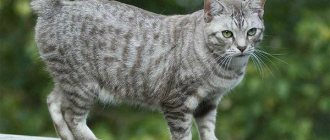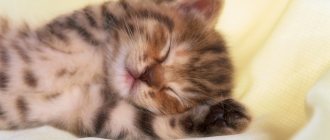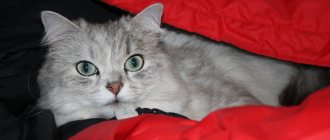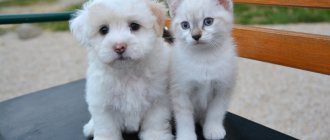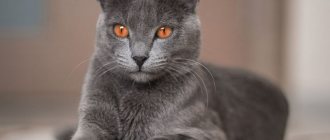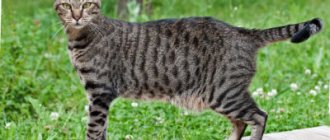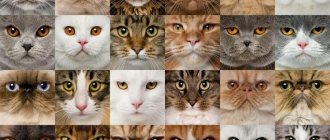Save the article:
What kind of pet can amaze with such an original appearance and variety of breeds as a cat without a tail?
Whether it's a miracle of nature or human intervention, these phenomenal creatures proudly walk around the world today.
Short-tailed cats have proven themselves well not only due to their charming appearance, pom-pom tail or lack thereof, but also due to their remarkable character traits.
If you didn't know that cats such as the Manx and Bobtail varieties exist, then it's time to discover a true feline miracle.
When a person first encounters a fluffy tailless creature, he immediately asks: where could such a wonderful cat come from? There are several explanations for the phenomenon.
Some believe that the first cat with a short tail appeared in Japan in the distant past, although the Japanese Bobtail breed was recognized only recently, in the 2000s.
Tailless Manx, according to legend, inhabited English lands back in the days of the Picts and Roman legionnaires, who allegedly brought the beauties to the island of Great Britain. They loved the cats, noted their unusual appearance and left them to settle everywhere.
Some people believe in the biblical myth that once a cat, who was late for the ark, had its tail pinched and broken off.
There are many versions, but the fact remains: cats without tails are popular today and this popularity is justified.
Character of Manx cats
Manx is an unpretentious pet with a calm character.
Cats become attached to family members and love to spend time with their owner, but will not impose themselves at the wrong time. They are not shy by nature, but can be reserved with guests. Natural curiosity and hunting skills make cats good pets for private homes. If you keep a Manx cat in an apartment, it would be a good idea to take her for walks in a harness.
Cats love to look at water, so instead of a bowl, you can use an automatic drinking fountain to provide your Manx with clean water and entertainment.
They love to hide small things and toys, so don't be surprised if you find a stash behind the sofa during spring cleaning.
Manx cats are friendly and careful with children. If a child starts playing, the cat will prefer to go to a quiet place rather than let out its claws. It is necessary to explain to the baby that the area around the tail, ears and whiskers (whiskers) are especially sensitive places on the cat’s body.
https://youtube.com/watch?v=V1Opw2tvHf4
Pros and cons of Siberian cats
Before deciding whether to get a cat of this breed, you need to carefully weigh its advantages and disadvantages in comparison with others.
To make this easier, we will give an approximate list of both - of course, for some one will turn out to be very important and the other quite insignificant, for someone the features that are not reflected at all below will seem important - but you can get a rough idea.
Pros:
- Friendly and energetic – the Siberian cat loves to play with people; when she is in a good mood, she is calm about being squeezed;
- Intelligence - it is quite easy to teach her the rules of behavior in the house, and she can even remember several commands;
- Beauty - they are fluffy and very beautiful, it’s not for nothing that in the West there are queues for every kitten;
- Health – they get sick quite rarely, especially if they are well maintained, and can live up to 15-20 years;
- Unobtrusiveness - if a Siberian cat sees that the owner has no time for her, she will not hang around, but will go about her business;
- The ability is almost everything that people have.
Minuses:
- The need for hair care. It will need to be combed regularly and thoroughly, otherwise hair will fly around the apartment, and the pet itself will lose a significant part of its external gloss;
- Need for walks - in a private home, a cat will often walk for most of the day, which can sometimes lead to torn ears and other injuries. In the apartment, she must be taken out for a walk at least for a couple of hours;
- Aggression towards other pets - such a cat will most likely not give life to rodents and other small pets. It can easily not get along with large dogs and other cats.
Cat breeds without a tail
There are not many breeds of cats with short tails in the world. The animal’s bizarre feature appeared not only thanks to the work of breeders. Some species are the result of a gene mutation. Here are those that have been carefully preserved and registered with the International Cat Federation.
Cymric
Affectionate small cat. It was obtained as a result of a random mutation of a Manx cat. The long-haired kitten that was born at that time was given to breeding a new breed of cats without a tail. The color is varied: from red to smoky with white spots. Long hair with a thick undercoat requires constant care; the pet is combed several times a week.
A cat breed without a tail is no longer a curiosity
The animal jumps well, and its muscular hind legs help it in this. Tailless cats overcome heights several times their height and can jump onto a table. The long hind limbs allow the cat to move in leaps, its gait is like that of a rabbit.
Note! This species gets along well with children, loves human attention, and is very attached to its owner.
Manx
The first kitten appeared in the 19th century. on the Isle of Man. Hence the consonant name of the breed. It was first shown at an exhibition in London, and has since gained popularity among lovers of cats without a tail. In appearance, the individuals are similar to representatives of the Cymric, but only the Manx has short hair. Caring for it is simpler: the pet is combed occasionally and washed when it gets dirty. The cat is playful and talkative, very curious about new people.
For your information! A curled cat tail may sometimes be present. This is not a defect in the breed. The kitten receives documents and is also purebred.
When crossing animals, one is tailless and the other is with a tail. This is done because the mating of two tailless representatives leads to a gene mutation, and the kittens can be born dead.
The preservation and enhancement of this species was achieved thanks to the inhabitants of the island. They believed that cats without tails brought them good luck.
Manx can be born with a curled tail
Japanese Bobtail
The Japanese Bobtail is another breed of tailless cat, with roots dating back to the 10th century. Animals were used on ships to exterminate rodents. This cat was considered part of the team and a mascot on sea expeditions. The animal weighs on average 3 kg, has a slender body and a complete absence of a tail or a small curled appendage. The coat is short and without undercoat, making it easier to care for your pet. In the apartment, the pet needs to be provided with personal space, a scratching post, and an elevation to monitor the situation.
Health Features of Tailless Cats
In general, tailless cats are in good health: they rarely get colds and are not susceptible to heart disease or infections. But some risk areas are still present.
Bobtails are susceptible to some diseases, but they rarely occur.
Diseases and defects
Genetic diseases are unfamiliar to tailless cats, but acquired ones occur due to the structure of the body and the characteristics of the organism:
- Proctitis (inflammation of the anus) occurs due to the structure of the tail, under which dirt and fecal particles can accumulate, leading to inflammation. It is treated with medications or surgery, depending on the severity and depth of spread.
- Urolithiasis disease. Mostly, Kurilian and Karelian bobtails get sick due to the different acidity of their urine. If your pet frequently urinates bloody urine, experiences pain when going to the toilet and refuses to eat, this is a sure sign of illness. Stones are removed surgically.
- Manx syndrome, or Manx syndrome. Manx and Cymric cats are susceptible to it. In the first 4 months of life, tailless kittens may develop abnormal spine development. This is followed by spina bifida, hernia, difficulty moving and other problems. The defect cannot be treated.
- In general, tailless cats are prone to spinal problems such as lordosis. But, fortunately, they happen rarely.
A feature of all tailless cats is their elongated hind legs (always longer than the front ones). They developed this unusual feature to maintain body balance without a tail.
Pixiebob
- The tail part of the presented specimens is shortened and does not really stand out. It is difficult to confuse these animals with other individuals classified as felines. According to their external characteristics, they are similar to lynxes, and the absence of a tail is only touching.
- Pets are endowed with ears of the correct build, on which there are tassels of hairs at the tips. Yes, there are whiskers, which, again, bring these felines closer to lynxes. To have such a miracle in your home is real happiness.
- The cats are large in size; according to estimates, the body weight can be 9 kg. However, average individuals weigh approximately 7 kg. The body is well built and muscular, the spine is strong. The animal represents a hunter and a friendly family member in one package.
- Initially, representatives of the family were bred in the United States of America. After some time, they became more popular, and breeders began working on cats in Canada and other countries. These cats are characterized by an increased number of fingers, which is why they are called cats with mittens.
Manx cats
It is believed that all cats without a tail descended from the Manx. In the description of this breed there are also references to cats with a fluffy long tail. Like other tailless cats, this breed has a calm and good-natured character. Easily adapts to any conditions, very hardy.
Cymric
The second name is Welsh cat. This cat, with short legs and a tail that is practically non-existent, is a direct descendant of the Manx. The body is round in shape, the hair is thick and of different lengths. The character is calm, loves to play, gets along well with children.
Purchasing a cat with a short tail will be an excellent choice: after all, it will become not only a decoration for your home, but also a true friend.
Cymric
Welsh cat. Suitable even for a large family due to the lack of a tail. It’s completely gone, not even an inch. There will be nothing to carry around. A round cat in all respects. Round eyes, stocky build, big chubby cheeks. A feature of the breed can also be called the difference in the length of the hind and front legs. The hind legs are somewhat longer. This feature is explained by aerodynamics: long legs compensate for the lack of a tail.
Upbringing
American Bobtails have developed intelligence. They easily learn the rules of behavior in the house and quickly get used to using a tray and scratching post.
Kittens usually receive basic socialization in the breeder's home. In the new apartment, the baby needs to be shown a potty and be closely monitored in the first few days. If the short-tailed cat does not immediately remember where to relieve himself, he begins to worry, sit down, the cat must be carefully transferred to the tray. A smart kitten will quickly understand what is required of him. You cannot hit your pet for peeing in the wrong place. His negative emotions will be associated with the process of evacuation itself, and not with the place. The cat will begin to hide in the corners, and it will be much more difficult to train him to use the toilet.
You need to immediately wean your Bobtail away from playing with your hands. A grown large animal can unknowingly cause serious injury to a person. When the baby begins to bite or scratch, the game must be immediately interrupted and offered a special ball, fishing rod, teaser or mouse instead of fingers. An active Snow-Bob will be happy to engage in special “entertainment” activities and will not tear up furniture or books.
Thanks to their extraordinary mental abilities, Bobtails are easy to train and can master some simple commands. The main thing is to organize classes in the form of a game, then the Yankees will happily study, enjoying the additional attention from the owner.
If a child does something illegal, it is enough to reprimand him in a stern voice. American bobtails try not to disappoint their owners and have a great sense of intonation. When a young cat loses control of energy during play, it is permissible to spray it with a spray bottle. Representatives of this breed do not like water very much. He will associate pranks with unpleasant sensations. In general, Bobtails are very obedient; problems with their upbringing rarely arise.
Purchasing a kitten
If your goal is to participate in exhibitions and breed Siamese cats, choose your pet carefully. The future winner must be of high blood, from titled parents and reliable breeders. The owners of a mother cat or cattery are required to issue a certificate indicating the date of birth of the kitten, the names of its and its parents, breed and color. Later this document is exchanged for a pedigree. The price of Siamese kittens, which will become participants in exhibitions and producers, reaches 800 euros and more. The more titles parents have, the more expensive their offspring will be.
The future champion must have high-born ancestors
If you need a cat for the soul and games, the costs will be much more modest and the choice will be easier to make. You can buy a kitten from a breeder or in a nursery, then it will definitely have all the characteristics of the breed. But you have the right not to be given documents if the animal will not be exhibited. The price of a small Siamese in this case will be 10–15 thousand rubles, and sometimes less.
There are nurseries in Russia where they seriously study Siamese and other oriental breeds. A list of some and their coordinates can be found here.
Criterias of choice
The potential winner and prize-winner of cat shows is meticulously chosen
It is important to exclude any grounds for disqualification. Already at a young age it is clear what the baby will become
By this time, dark markings should appear, whether the tail is straight, the number of fingers, what color of the eyes - everything is visible. When choosing a kitten, check the criteria for compliance with breed standards. And, of course, the future pet should evoke sympathy from the owner. It is difficult to raise a champion without mutual love.
When purchasing a kitten, you need to understand what your goals are.
A kitten that is bought for pleasure does not need to be subjected to strict inspection. The main selection criteria will be character and health. Do not choose a pet at the market, only at home. There you will see how a cat is kept, take a good look at the babies and their mother
Pay attention to the condition of the kitten's fur, eyes, and ears. If something worries you, refuse to purchase
The Siamese cat was our first pet. In the apartment of the mother cat's owners, we saw kittens hanging in a bunch right on the wall (thick vinyl wallpaper was in fashion at that time). It seemed funny. But a day later the little Siamese began to hang on our wallpaper. And we had no time for fun. It took a long time to wean her off the bad habit.
Age of kitten for moving to a new family
Experts do not recommend purchasing a kitten younger than 2.5, or preferably 3 months. Kids react painfully to parting with their mother and moving. Usually by 3 months they get used to independence, know how to eat and are toilet trained. Check with the cat's owners what they fed the kittens, and at first stick to the same diet. By this age, little Siamese should already have received mandatory vaccinations and deworming.
Cats that are completely tailless
Even representatives of the same breed may have a tail of different lengths, or it may be completely absent. An example of this is Manx cats.
2.1
Manx
Manxes are large cats, weighing from 4 to 7 kg, with a round, spherical and muscular body, covered with short and thick hair of different colors. The Manx head is large, round, with large and slightly sagging cheeks, a heavy chin and a small nose. Her decoration is expressive oval eyes. The ears are medium sized and pointed.
No tail, but so much charm!
A peculiarity of the breed is the presence of individuals with tails of different lengths. Based on this feature, several groups are distinguished:
- 1. Rampi - completely devoid of a tail.
- 2. Reaser - animals with a very short tail, more like a growth (1-2 vertebrae).
- 3. Stumpy - cats with a vestigial tail consisting of 4-8 vertebrae.
- 4. Longs are animals with a tail of normal length.
Manx cats are friendly and calm animals, ideal for keeping at home. However, in domestic nurseries, kittens of this breed are still rare and quite expensive. The average cost of a Manx kitten is 30,000 rubles.
2.2
Cymric
Kymriki were obtained artificially, as a result of the fixation of the tailless gene in combination with long hair. This is not easy for breeding, so the breed is classified as very rare. Most of its representatives live in the United States.
Cymrica is distinguished by:
- average weight (4-6 kg);
- long fluffy fur;
- short front legs, which is why the animal’s body takes on a roundish shape and its gait becomes jumping;
- a rather large round head with well-developed cheeks, a massive chin, wide-set large eyes with slightly upturned outer corners, the color of which depends on the color of the coat;
- medium-sized ears with rounded tips.
Cymriki - cats with an easily recognizable appearance
The fur of the Cymric deserves special attention: it is very thick, with dense and soft undercoat on the chest and neck, and on the sides of the head. Tufts of hair on the paws between the toes and in the ears are considered obligatory. Toward the back of the body, the coat becomes longer, forming a skirt and rather large pants.
Kymriki are distinguished by their affectionate and playful character, and they:
- Not prone to violent entertainment. The owners can rest assured that the furniture, dishes and curtains are intact.
- Get along well with other pets.
- They get along well with children of any age and play with them without releasing their claws.
- They cannot stand loneliness and constantly need attention and company.
Cymrics have a quiet, pleasant voice. Being in a good mood, they are able to have long, emotional “conversations” with their owners. Breeders also note the intelligence and intelligence of the Cymric, which allows them to train the animal.
Reproduction and lifespan
Manx cats become adults quite late, at the age of 1.5 years. When mating cats, the rule is followed: one partner is tailless, the other with a normal tail. Usually 2-3 kittens are born; tails in newborns may be absent, shortened or long.
Manx cats get along well with dogs and small children.
In the old days, breeders would dock kittens' tails if their length did not meet expectations. Most associations of felinologists have banned this operation so as not to violate the natural design and not to mislead future owners. Manx syndrome may appear in the first months of life. Sick kittens die or are subject to culling.
The genetic complexities associated with taillessness suggest that Manx breeding is carried out by experienced breeders with mandatory veterinary supervision. Healthy kittens grow quickly, get sick little and begin to age at 14-15 years. There are long-livers who remain playful at the age of 18.
Origin story
Before delving into all the characteristics of the original tailless cats, it is worth learning about the history of their origin.
Stories related to the appearance of cats without tails are shrouded in a huge number of different legends, fairy tales and speculations. For example, there is a belief that one day a cat was late for boarding the animals into Noah’s Ark, and her tail was pinched by the door. In Thailand, there is another interesting legend that says that there were Thai beauties who used short cat tails to preserve jewelry.
There are other unusual and fabulous stories about the appearance of tailless mustachioed pets.
All varieties of tailless cats can be divided into two main subgroups:
- Manx;
- bobtails.
All other existing varieties of these animals arose precisely on the basis of these groups. Most likely, these lines developed parallel to each other or could have been introduced in a certain time period from one area to another. At present, it is impossible to establish this fact precisely.
Bobtails have their origins in Japan. These individuals first arrived there on merchant ships in 530-540 BC. If you believe the legends, in those days they still had tails. However, fear of the evil forces contained in the forked tail of the divine cat Nekomata, which brought illness and death to people, led to the fact that they soon began to be chopped off.
Animals that did not have tails began to be called maneki-neko. It was believed that such pets bring wealth, luck and happiness to their owner. Such actions in relation to tails over many years eventually led to a special gene mutation, and kittens began to be born with a very short pom-pom tail. The Japanese were incredibly happy about this phenomenon. They believed that using this method they were able to defeat the evil god with the help of their pet mascots.
There is an opinion that cats instinctively chewed off the tails of their kittens to protect them from unpleasant consequences. Another version says that the mutation occurred on its own, without external human influence. The Japanese only consolidated it using selection methods.
As for the Manx breed, it was born on the Isle of Man, which is located next to Great Britain. It was from there that representatives of this subspecies were distributed throughout the countries of Europe and America. It is believed that the ancestors of these animals are British shorthair cats, in which the “tailless” mutation was preserved by selection.
The first mention of cats without tails was made in 1750. Due to their compact size and isolation, such animals interbred with each other. Due to such actions, other representatives of the breed with very short tails began to be born in the future. From the very beginning, all these animals had short hair, while long hair was considered a deviation from the norm. However, over time, longhaired Manx cats began to be bred in Canada as representatives of a separate breed.
Character and intelligence of the bobtail
Friendliness
Despite the fact that the Kuril Bobtail is very similar to a wild lynx, it is a surprisingly kind and cheerful animal that loves human company and gets along well with all household members.
In terms of devotion to its owner and boundless friendliness, it is rather a dog
than a cat. She always tries to be close to people, is interested in their affairs, and has a pleasant and unique voice.
Bobtails love to sit on people's laps, to be in the center of all events, but at the same time they are unobtrusive. If they see that the owner has no time for them right now, then they do not particularly insist on the next portion of attention to their person.
But it is important to remember that cats of this breed are very attached to their owner.
, and if you are away from home for a long time, your pet will be very bored.
Get along with children and other animals
Unlike most other cat breeds, bobtails do not “walk on their own”, but look for opportunities to follow people everywhere. Along with this, they are extremely patient and never offend children, even if they constantly drag them around, pull their ears, etc.
If there are other cats of the same breed living in the house, they almost never quarrel and are even able to establish their own hierarchy.
In addition, they are distinguished by amazing courage, are not afraid of dogs at all and make friends with them.
Activity
Kurilian Bobtails are active and curious cats
It is important to understand that these cats are very active. They need free space to play, jump, run and climb.
They can jump very high and climb into the most inaccessible places. However, damage to household property from their “adventures” is no greater than from representatives of other breeds.
An interesting feature of Kurilian Bobtails is their love of water.
, they swim, dive perfectly and are even able to catch fish in a pond on their own. The hunting instinct of these animals is simply excellent. They enjoy catching mice and rats.
Intelligence
Bobtails are very smart and easily remember what they are allowed to do and what they are not allowed to do.
The Kurilian Bobtail can be taught to walk on a leash, perform tricks and even play games.
An important and useful feature of these cats is that they almost never mark their territory. This, of course, can happen, but only if cats of a different breed live in the house.
Manx cat
At first glance, these cats may give the impression of something spherical, which is confirmed by the absence of a tail. But despite the lack of a tail, these pets are endowed with character and personality. Such cats are smart, patient, and will not have problems adapting to new conditions. As a rule, they give themselves completely to their owner, but they also get along well with other family members. And not only with people, but also with animals.
These cats are characterized by long hair. As for color, it can be very diverse. On average, the weight of an adult cat is up to 5 kg, cats weigh about 3-4 kg. It is noteworthy that Manx cats love water. If you turn on the water in the sink or bathtub, don't be surprised when you see your pet under the running water. But this does not mean that Manx cats love to swim. A cat can sit in the rain for a long time, but you have to try hard to get the animal into the bathroom.
Caring for tailless cats
Tailless cats do not require special care. However, owners should remember a few nuances:
- Tailless cats are prone to infections of the anus and may have difficulty going to the toilet, so the owner should not only closely monitor the well-being of the pet on the tray, but also wipe the cat’s area around the anus after each visit to the tray;
- care for the coat of these cats varies depending on the variety (long-haired/short-haired): each cat will need a rubber brush, a combination comb, a furminator and a bristle brush; short-haired dogs are combed 2 times a week (during the molting period - 4-5 times and 1 time with a furminator), long-haired dogs - 3-4 times a week (during molting - every day and once with a furminator);
Tailless cats are easy to care for
- Regular cleaning of the ears (every 5 days) and daily wiping of the eyes with a natural damp cloth are mandatory, as is trimming the nails.
Japanese Bobtail
The Japanese Bobtail was bred in the Land of the Rising Sun. From time immemorial, indigenous people have had a special relationship with cats. In Japanese national culture, it was customary to consider four-legged “girlfriends” of the devil. According to beliefs, it was in the tail that evil spirits lurked.
The famous “maneki-neko” figurines are a tribute to the Japanese bobtail, which saved the Japanese from a mouse invasion several thousand years ago. Representatives of this breed have a small tail with elongated hair, resembling a pompom, and long hind legs that are longer than the front ones. Any colors are considered acceptable except:
- lilac;
- Abyssinian;
- chocolate;
- colorpoint.
The Japanese are inquisitive, talkative and friendly. These cats quickly get along with small family members and love to chase balls. They show devotion like samurai, choosing only one most beloved master.
Japanese cats without a tail are a native breed without genetic diseases. With proper care and maintenance, their maximum lifespan is 16 years.
Bobtails are bob-tailed cats without a tail.
One of the most popular breeds of cats with a “pom-pom tail” in the world is the American Bobtail, which is distinguished by a muscular body and a wide, almost square head.
Due to the special shape of their eyes, it seems that these cats are always ready to hunt. However, they have a peaceful character, which makes it easy to get along with any pets, even dogs. Karelian bobtails first appeared in Russia. The natural mutation of cats in the area of Lake Ladoga took place completely without anthropogenic intervention. The reason for the appearance of the breed was the crossing of an ordinary domestic cat and a Norwegian forest cat.
Another domestic cat without a tail is the Kurilian bobtail, which appeared thanks to Japanese short-tailed pets brought to the Kuril Islands. The gene responsible for the absence of a shoot is dominant, which is why the likelihood of a long shoot appearing with any type of crossing is practically absent. Kurilian Bobtails are distinguished by their loyalty to their owners, friendliness and curiosity.
Kurilian Bobtail
Thai or Mekong Bobtails are an artificial breed bred by European and Russian breeders. The peculiarity of these cats is the wide variety of bends of their processes. Small tails curl intricately, practically not repeating in different individuals.
Japanese Bobtails first appeared in the Land of the Rising Sun and were prized for their supposed association with evil spirits. The breed gained popularity after World War II. And it was established on the American continent in the 1960s.
qualities)
Due to the fact that the breeds in question have virtually no tail, they have well-developed other muscles. As for the very character of cats, they are distinguished by kindness and affection. Such individuals will become excellent companions for one person or perhaps a large family.
Short-tailed cats are quite playful, so you won’t feel sad. Individuals are quite indifferent to other animals in the house, so you can safely get someone else. Cats also have high intelligence. Thanks to this, you can safely train the animal. Rest assured, Murka will understand you perfectly.
Content Features
In general, caring for short-tailed cats is not very different from general grooming requirements. The only nuance is the need for washing with special products approximately once every two weeks. After water treatments, your pet’s fur coat should be thoroughly combed with special combs or a furminator.
We must remember that, regardless of breed, these are very active cats that need intense physical activity. They make ideal playmates for children.
Bobtails appreciate attention, are sociable and are ready to spend all their time in the company of their owners. They are rarely and reluctantly left on their own, they get bored and may even get sick.
Representatives of bob-tailed cats tend to have poor health. They need a balanced diet rich in micronutrients. It may take a long time to find the right diet. Read about how to choose the right diet for your cat on our portal.
It is important to maintain contact with the supervising veterinarian and conduct timely examinations and vaccinations.
If the animal is not suitable for further breeding, it must be sterilized.
List of tailless breeds
Among tailless cats, there are breeds that were bred a long time ago, and there are those that breeders have worked on quite recently. The most famous breeds of cats without a tail are:
American Bobtail – bred in the early 50s in North America. The American bobtail received real recognition only 20 years later. Cats of this breed have high intellectual abilities, do not particularly impose their company on people, and are unusually peaceful. The coat is short and thick, resembling a fur coat. By constitution, American Bobtails are strong and have well-developed muscles in the hind limbs.
The Karelian Bobtail is a rare species of cat without a tail, the appearance of which is not the result of selection. The Karelian Bobtail appeared as a result of mutational changes in the genetic code. Flocks of cats were discovered near Lake Ladoga and scientists agree that this breed appeared as a result of natural crossing of domestic cats and wild Norwegian cats.
The Kuril Bobtail is a breed of Russian short-tailed cat, bred through selective breeding. As a result of crossing the Siberian cat and the Japanese bobtail, brought to the islands of the same name as the breed, a new breed was born. The gene responsible for the short tail is dominant, so these cats do not have long tail processes in the litter.
The Mekong Bobtail is a breed of cat without a tail, also called the Thai or Royal Bobtail. The origins of the Mekonese Bobtail come from Siamese cats. The peculiarity of this breed is its tail, which curls into bizarre shapes.
The Japanese Bobtail is a cat without a tail, bred in the Land of the Rising Sun. In Japan, since ancient times it was believed that ordinary domestic and wild cats have a connection with evil spirits, being intermediaries of the devil. Therefore, cats born without a tail had special significance and honor.
Welsh Bobtail (Cymric) is a breed bred in Wales, characterized by a round body (the body looks like a sphere). Their hind legs are much longer and stronger than their front legs, which gives them the ability to jump high and balance well at heights.
The Manx cat is one of the founders of the tailless cat breed. Litters often contain kittens with long tails. By the standards of bobtail cats, this is not an obstacle to further breeding of animals and participation in exhibitions. It is recommended to breed Manx cats with other whiskered pets to obtain pure and new species. But crossing one type of Manx cat causes the death of kittens in the womb.
There is also a list of hybrids that is quite impressive. In each hybrid name, the prefix “bob” means that the cats do not have a tail. The main ones are:
Pixie bob. Felinologists call such cats small lynxes. Specialists from the United States worked on the appearance of the hybrid.
Toy bob. A hybrid of tailless cats bred in Rostov, Russian Federation. This breed branch is experimental and is not recognized by the World Organization of Cat Breeders.
Oooh-bob. Cats obtained by crossing Manx and Siamese cats. A peculiarity of the tailless animals of this hybrid is the inheritance of the color of Siamese cats. It is also experimental and not yet widely used.
Snow bob. Cats bred in America that do not have a tail, but at the same time professional breeders are trying to get a new color similar to the snow leopard.
Twisty bob. Small cats that resemble kangaroos due to the fact that the hind limbs are much larger than the front ones. Cats of this breed love to sit on their hind legs, tucking their front legs, which gives them a great resemblance to wild Australian kangaroos.
Tailless cats: history and their types
Felinologists even today cannot agree on how tailless cats appeared. Several versions have been put forward:
- During research work, scientists have repeatedly confirmed the fact that most wild cats gave birth to ordinary babies, but chewed off the kittens’ tails within 24 hours. It is believed that the instinctive ridding of babies from the “weak spot” eventually led to a natural mutation and the animals became short-tailed.
- A natural mutation without prerequisites such as biting off the tail, which led to short tails.
- The third version applies only to American bobtails and pixie bobs. Many believe that these cats descended from lynxes themselves.
A distinctive feature of all tailless cats is their short tail.
Types of tailings
Conventionally, all tailless cats can be divided into two groups: Manx and Bobtail (except for the Pixie Bob and American Bobtail, whose tails should be as close as possible to a lynx). Each of them has its own tail classifications:
- Manx: Rumpy or Dimple Rumpy are the most highly prized cats. Their tail is completely absent; in the place of its growth there is a small hole. Usually it is cats like rumpy that receive titles at shows.
- Riser or rampy riser - their tail consists of 1-3 vertebrae. Such cats can participate in exhibitions if the tail does not exceed 2–4 cm in length.
- Stumpy - from 4 to 14 vertebrae, often lumpy and knobby.
- Longs or tails. The tail is almost the same length as that of tailed cats. Often the tail has to be docked, since the vertebral discs of long-haired cats can ossify.
- Stump:
- from 2 to 8 vertebrae;
- from 4 to 15 vertebrae;
- consists of 5–11 vertebrae;
- the beginning of the tail (approximately 5–7 vertebrae) is identical in structure to the tail of a simple cat;
Photo gallery: types of tails
Cats with a retracted bobtail do not participate in exhibitions
Cats with a tail (or rather, lack thereof) like rumpy are valued the most
The tail-broom looks like a big fluffy pom-pom
The stump tail is characteristic only of bobtails.
The riser-type tail is almost invisible
A stumpy tail is considered a fault.
The longi tail type is similar to a regular tail.
The spiral tail should be well feathered
Japanese Bobtail
From the name of the breed of these animals it is immediately clear where they come from.
The main difference of this species is a very slender, beautifully built physique. Also, these cats are somewhat smaller in size than all the breeds described above. The eyes deserve special attention, since their specific shape and bright color are the main symbols of the breed.
The head of Japanese Bobtails is triangular in shape, with wide erect ears.
Such animals have a tail, but it is unusually small, sometimes even completely invisible. Their fur is smooth, fluffy and soft. These cats practically do not shed. As for colors, animals with three colors are most often found.
The peak demand for these animals occurred in the post-war years. And this species of animal was officially recorded in America in the 1960s.
Japanese Bobtail
Historical reference
The Mekong Bobtail is a direct descendant of the Mustachioed Murki, which lived in Thailand for many centuries. From historical documents it is known that these cats have long been sporting hooked tails, broken in the most unimaginable way. The peculiarity of the Siamese princesses even managed to acquire legends. According to one of them, the tails bent under the weight of the jewelry that the cat was supposed to wear on the tail while the owner was bathing. According to another, the curled tails are a consequence of the temple cat fulfilling its duties: to guard the relics, wrapping them in a long host for greater security. Of course, these are just beautiful legends, and the special structure of the tail is the result of a natural mutation.
When Thai cats came to the UK, breeders paid attention to the tails, but unanimously decided - only a straight tail. However, the first Thais, and subsequently the Siamese, participating in exhibitions had creases of varying degrees. But years of selection made it possible to get rid of the defect. Today, such kittens are rarely born and are necessarily discarded.
But Russian breeders took a liking to the unusual ponytails of Thais. True, they decided to abandon the original name of the breed. Thai bobtails seemed to breeders to be not Thai at all, that is, different in many respects from their ancestors. The name “Mekong” comes from the name of the Mekong River, which flows through the territory of Indochina.
Today this cat breed is recognized by the WCF as a native breed of Russia and the WFF (an organization formed in Russia in 2004). Outside our country, bob-tailed descendants of Thai cats are little known. There are several nurseries in Germany, Latvia, Belarus and the Czech Republic.
In the Aegean Sea, there are many islands that carry the living history of ancient Greece and Byzantium. Tsikladis is one of the little-known islands that became the homeland of the modern Aegean cat. Unremarkable for the islanders, the “murki” lived next to people for hundreds of years. The main occupation of the local population, naturally, was fishing; the owners left their homes for a long time, and the cats were left to keep order.
The Aegean cat breed has gone through all the stages of natural selection; at the time of its inception, pneumonia was a death sentence for people, to say nothing of veterinary medicine or breeding programs. Severe weather conditions during storms, temperature changes, viral infections and bacterial outbreaks, low tides, and then hunger “mowed down” the wild ancestors of Aegean cats, tempering the gene pool of the future breed.
READ Toy Bobtail (Toybob, Miniature Mekong Bobtail, Dwarf Bobtail, Skif Toy Bob, Skiff Toy Tai Bob)
Perhaps the everyday life of the islander cats would have gone unnoticed if not for a random coincidence. No, the breed was not noticed by a famous breeder or veterinary doctor; the Aegean cat was encountered by historians who explored the island. Further, the working notes of the research group ended up at the institute, where they were published in the form of a report, and a detailed description of the cats’ behavior attracted the attention of fans of four-legged animals. By the way, in the description of appearance, there were no special features; the ancestors of the “Aegeans,” like their modern counterparts, look more than usual.
Hybrid breeds
Hybrid tailless animals are the result of crossing several breeds. They have not yet received recognition, so little is known about them. The list of hybrids is small:
- Alaskan snow cat, or snow bob, is a white variation of the American bobtail;
- Scythian-toy-bob is a Russian breed of miniature cats, a descendant of the Mekong Bobtail and cats with the miniature gene, distinguished by its color-point color;
- oohee-bob - the result of crossing a Siamese and a Manxam - as a result, the color-point Manx was obtained;
- The Highlander is the most unusual short-tailed cat, obtained from crossing an American Curl and an American Bobtail, and inherited a short tail and curled ears from its parents.
The wild family of short-tailed cats is limited to lynxes and caracals. There are the following types of lynx:
- Iberian (Pyrenean) lynx;
- Canadian lynx;
- red lynx;
- common lynx.
There are separate breeds of hybrid cats without a tail. These include:
- The pixie bob was developed by the Americans. The cat looks like a lynx. She lacks a tail, but has “mittens”. The animal has 7 toes on its front paws and 5 on its hind paws.
- The toy bob was developed by the Russians, but is not yet officially recognized.
- Oohee Bob - appeared as a result of the mixing of Siamese and Manx cats. Has a two-tone color. It can be short-haired or long-haired.
- Americans are still working on the Snow Bob breed, trying to breed cats with perfectly white fur.
- Twisty has very short front legs and long hind legs. Externally, the breed resembles a kangaroo.
Choosing a purebred pet
Getting a cat without documents is not difficult. You can take a suitable pet:
- at a homeless animal shelter;
- in the nursery (unscheduled mating or presence of defects in the animal);
- by advertisement in various media (print publications, Internet resources, etc.);
- at the market, near the metro, at a transport stop;
- in a pet store;
- from neighbors, friends, etc.
Outbred kittens can be bought for pennies on the market
When choosing a kitten, you need to consider the following points:
- Baby's activity and mobility. He should run to get acquainted with curiosity, and not cower in a corner in fear.
- Healthy appearance. There should be no discharge from the eyes, ears or nose. The anus is pink and clean.
- Condition of the oral cavity. The teeth are clean, without tartar deposits. Gums are shiny. Pink and don't bleed.
- Wool cover. The fur is shiny and even, without bald spots or tangles.
- The abdomen is firm but soft.
- No defects (third eyelid, extra fingers, tail creases, etc.).
The kitten should look healthy
Bobtail breeds
American Bobtail
Tailless American Bobtail cats grow very slowly. It can take up to three years for a cat to reach adult size. On average, the weight of an adult cat is about 6-7 kilograms, females - up to 5 kg. The lifespan of such pets can reach 15 years.
The body of such animals is massive and muscular. The tail may be slightly curved or straight. The pet's head is wide, one might even say square-shaped. Thanks to the shape of the eyes, it may seem that the cat has a hunting look. As for the color, it can be absolutely anything.
As for character, cats of this breed are perfect for large families, since they tend to become attached to all family members. American Bobtails can get along with other pets, including dogs, without any problems. In addition, they get along well with children. If a stranger comes into the house, the cat will not hide under the sofa, but will come out to meet him to sniff and get to know him.
Kurilian Bobtail
The appearance of the “Kuril” is similar to the American Bobtail. As in the previous case, they have a muscular body. They can be short-haired or long-haired, and the color of the coat can be completely different - from snow-white to spotted. The nose of such cats is wide and straight. The ears are small, can be slightly tilted forward, with rounded ends.
The tail can be either very short or consist of several spiral nodes. At first it may seem that the “smoker” has a thick neck. But this is only at first glance, since these pets are characterized by a thick undercoat.
In their habits, Kurilian Bobtails are similar to dogs. These animals are smart, playful, love communication and are extremely loyal to their owners. They will always be nearby. If the owner allows, the cat will sit on his lap; if not, he will sit at his feet. What is remarkable for this breed is that cats practically do not mark corners.
Japanese Bobtail
Japanese Bobtail cats have a medium body size. Unlike the “Americans” and “Kurilians” described above, they are not so massive and muscular. The cat's figure is slender and folded. We should also highlight the shape of the eyes - they are characterized by a small “Japanese” cut. The body is graceful, the legs are of medium length, moderately muscular. The ears are wide and erect, and the head itself vaguely resembles the shape of a triangle. In most cases, the eyes of these cats are bright.
The tail of this breed is very small, hardly noticeable, but it is there. In some cases, its length can reach 12.5 cm. The fur is soft, there is a small undercoat. These cats practically do not shed. In general, the fur is of medium length, slightly shorter in the area of the muzzle, paws and ears. But the hair on the tail is much thicker. These breeds are characterized by a three-color coloration.
Mekong Bobtail
Cats of this variety are characterized by dog-like habits. Pets often carry various things in their teeth, can calmly walk outside with a leash, and simply love to run after a ball and then carry it to their owner. They hardly scratch, but when defending they can cling their teeth to the enemy.
Cats of this breed have a body with rectangular features. It is usually small and similar in description to the Japanese variety. The tail has at least three vertebrae, and itself is made in the form of knots or a hook. The head is oval in shape, the chin is strong, the ears are tilted back. The ears are also characterized by rounded tips. Eye color in most cases is bright blue.
Karelian Bobtail
The Karelian Bobtail breed is another type of indigenous animal. The closest relatives of these pets are forest cats from Norway. But they have little in common with the “Smokers”, as it might seem at first glance.
They are characterized by long fur, especially on their pants, ears, neck and cheek area. To date, little is known about this breed. Specialists are engaged in breeding work on breeding pets.
Purchasing a kitten
There are few nurseries in Russia that breed Korats. Such animals can be found from private breeders, but most often these are breeders who deal with Russian blue cats or British blue cats, so the future buyer needs to be very vigilant when choosing a baby.
A breeder I know told me that in our city (Penza) there are no such cats at all. I found several advertisements with Korat kittens and decided to contact one of the numbers provided. During a phone conversation, the breeder explained that the cats look like Korats, but in fact they are the offspring of a Russian Blue cat. When I asked why she was misleading people, the woman explained that most potential buyers are not interested in purebreds. They say that people often look for beautiful cats that look like purebred cats, but they don’t even ask about the kittens’ parents.
Most often, kittens of Russian blue cats are passed off as Korats.
How to choose a Korat kitten
Any purebred kitten must meet the following criteria:
- beautiful and well-groomed appearance, its compliance with the breed;
- breed-specific behavior of the baby;
- availability of necessary documentation;
- suitable age.
First of all, the kitten should look healthy. His ears, eyes and nose must be clean, as well as his skin, without wounds, scratches or other damage to the skin. The tail should be smooth (exclude kinks, knots and other tail defects), the tummy should be rounded, but not hard. The animal should be moderately active, playful and friendly
If a small cat does not give in to hands, shows aggression, then, most likely, he does not receive enough attention from his mother or people, or is afraid
It is recommended to choose a kitten that will behave better and friendlier than the rest. I usually try to choose those babies that are easy to handle, but not intrusive
Pay attention to all the droppings. Some kittens will ask to be held and meow, and one kitten (usually the smallest) will sit in the corner and be silent.
Such quiet people grow up withdrawn. I try to choose “average kittens”. They grow up kind and moderately active.
Only healthy and well-groomed Korat kittens will grow into beautiful and kind pets.
No less important is the documentation that the breeder has. The kitten must have a veterinary passport
In addition to photographs and information about the breed, this document contains information about all medical operations performed (if any) and vaccinations. In addition, the baby must have a pedigree. Such paper is required if the breeder calls a blue kitten a purebred. It lists the cat's parents. This is the only way to confirm the purity of an animal.
Also, look at the baby’s fur. Russian kittens have a gray undercoat (thin downy hairs hidden in the main coat), but shorthaired kittens do not have such fluff. Part the fur with your fingers and look at the fibers. Their ends should be slightly lighter than the main part of the hair. Korat kittens also have a heart-shaped head almost from birth. The eyes of a silver cat will be gray-blue, but people usually don’t pay attention to their color at a young age. The paw pads should not be yellowish-gray like other gray cats. The tips of the ears should be rounded from birth.
When choosing a kitten, pay attention to the shape of the face and paws
The age of a kitten at which it is better to adopt it
The future owner of the Korat will want to take the pet when he is very young. There may be several reasons for this desire. Some people will want to see how the kitten grows and develops, while others will decide that moving the baby early will help him quickly adapt to new conditions. But in any case, it is not recommended to adopt a kitten until it is at least 3 months old.
There is a psychological connection between a cat and her kittens. If you tear your baby away too early, he may grow up unstable (aggressive or withdrawn). This will affect the behavior of the animal in adulthood. A cat that has experienced such severe stress at an early age can damage furniture, bite and scratch, go to the toilet in the corners of the apartment, etc.
Up to three months, kittens must be fed and raised by a mother cat.
An equally important reason why a cat can be adopted only after 3 months is vaccination. Between 2 and 3 months the animal will receive its first vaccinations, because by this age the immunity received from the mother will begin to decline.
To ensure your cat is healthy and survives in new, unusual conditions, adopt him no earlier than the recommended age.
